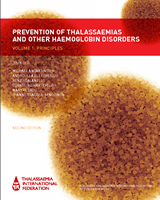All rights reserved.
The publication contains the collective views of an international group of experts and does not necessarily represent the decisions or the stated policy of the Thalassaemia International Federation.
NCBI Bookshelf. A service of the National Library of Medicine, National Institutes of Health.
Angastiniotis M, Eleftheriou A, Galanello Ret al., authors; Old J, editor. Prevention of Thalassaemias and Other Haemoglobin Disorders: Volume 1: Principles [Internet]. 2nd edition. Nicosia (Cyprus): Thalassaemia International Federation; 2013.

Volume 1 of the Prevention Book presents the principles of a programme for the prevention of the thalassaemia and other haemoglobin disorders, including a description of the various types of disorders requiring prenatal diagnosis, the strategies used for carrier screening, and a number of annexes listing upto date epidemiological and mutation data on thalassaemia. This book was written for use in combination with Volume 2, which describes many of the laboratory protocols in great detail.
The haemoglobin disorders are the most common clinically serious single gene disorders in the world with an estimated 300,000 affected births each year, of which approximately 60,000-70,000 are β-thalassaemia major. However, these figures are just an estimate -and as there have been few in-depth, reliable epidemiological studies into the incidence of Thalassaemia in many parts of the world, they are likely to be a gross underestimate. Although a detailed analysis of molecular variance in the thalassaemias exists in almost every affected country of the world, true gene frequencies for many populations are unfortunately still not available. Indeed, this book indicates how, in addition to preventing new births of affected children, a greater emphasis on prevention is likely to improve knowledge of the epidemiology of thalassaemia through pilot studies assessing the prevalence of the disease in different areas.
The benefits of prevention programmes have been clearly demonstrated by a number of Mediterranean countries over the past 30 years. The purpose of this book is to draw on this experience, and to lay out the issues and approaches involved in preventing new births of children affected with haemoglobin disorders.
The authors present the advantages for establishing prevention programmes, as well outlining the tools required for such programmes to be truly effective - understanding the epidemiology of the diseases concerned and developing appropriate health education programmes that are sensitive to prevailing cultural and religious norms.
As research into genetic disorders continues apace, the screening for and diagnosis of haemoglobin disorders, including prenatal diagnosis, are becoming increasingly significant aspects of prevention - along with genetic counselling and the need for medical specialists to be ever more sensitive to the power and complexity of the information with which parents are being presented. These subjects are addressed in detail, including problems associated with screening for the haemoglobinopathies.
Many innovations have occurred since the publication of the First Edition of this book in 2005, and therefore every chapter in this Second Edition has been revised and updated. In addition, we have included a chapter on newborn screening of the haemoglobinopathies, as several European countries have established national screening programmes for sickle cell disease and other haemoglobinopathies since the publication of the first edition. We are confident that this book, together with the revised Volume 2, will continue to provide a valuable tool and resource for all diagnostic laboratories engaged in the prevention of the thalassaemias and other haemoglobin disorders.
Of course the prevention of thalassaemia remains a delicate issue and the authors remain sensitive to this fact and have no wish to simplify or minimise the significance of the issues involved. Rather, we hope this book will contribute to constructive debate on the issue while encouraging ongoing pioneering work in the field of prevention.
The Editors
All rights reserved.
The publication contains the collective views of an international group of experts and does not necessarily represent the decisions or the stated policy of the Thalassaemia International Federation.
Your browsing activity is empty.
Activity recording is turned off.
See more...